Holger Heyn is ICREA Professor at the Centro Nacional de Análisis Genómico (CNAG). His Single Cell Genomics group is specialized on advanced single-cell and spatial sequencing technologies and the development of computational toolkits. The group integrates genomic data from individual immune cells to chart cellular identities and their roles in diseases, by combining expertise in genomics, computational biology and immunology. Dr. Heyn published 120 articles (20,119 citations, H-index of 64) and is member of the Human Cell Atlas project, where he co-chairs the Standards and Technology Working Group and the Spatial Program. As Scientific Co-founder of Omniscope, Dr. Heyn brings high-resolution profiling technologies to clinical application, developing advanced diagnostics and therapeutics tools.
Research interests
Dr. Heyn is a Genomics scientist investigating cellular mechanisms in health and disease. He is an expert in single-cell and spatial genomics with a focus on immune diagnostics and therapies. Dr. Heyn leads CNAG’s Single Cell Genomics group, merging tech and computational expertise for translational and clinical research. The group contributes to the Human Cell Atlas (HCA) Project to create reference maps of all human cells, with projects to build atlases of the immune system, the pancreas and the kidney. Dr. Heyn is co-chairing the HCA Standards and Technology Working Group, leading efforts to define best-practises of emerging single-cell and spatial technologies. Public and private funding supports his translational work to determine the plasticity of immune cells in oncology and inflammation. The group’s ultimate goal is to transform single-cell and spatial technologies into clinical tools for precision diagnostics and the development of next-generation immuno-therapies.
Selected publications
– Salvador-Martínez I, Murga-Moreno J, Nieto JC, Alsinet C, Enard D & Heyn H 2024, ‘Adaptation in human immune cells residing in tissues at the frontline of infections‘, Nature communications, 15 – 1 – 10329.
